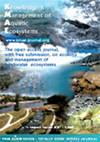热水中的水生生物群:作为气候变暖影响类似物的流变二烯温泉排放物的热梯度
IF 1.7
3区 环境科学与生态学
Q3 FISHERIES
引用次数: 3
摘要
温泉的特点是水温高于36.7°C。温度随流体远离弹簧通风口的距离而降低;这种自然梯度为研究水温对水生生物群的影响提供了一个独特的机会。本研究调查了澳大利亚昆士兰北部热带温泉综合体流出物中水温与水生无脊椎动物和底栖硅藻的关系。水的温度范围从62.7°C到最下游的26.0°C。底栖硅藻和水生无脊椎动物的丰富度随着温度的下降呈线性增加,而热喷口中没有物种存在。多变量分析表明,两种群落对温度梯度均有响应。在40°C至42°C之间,水生无脊椎动物丰富度下降,组合组成发生变化,表明在该温度下存在阈值。附近的Einasleigh河经历了几次超过40°C的水温高峰,这与这个阈值水平相对应。这些关系表明,气候变化下水温的持续升高会降低热带水生生态系统中水生无脊椎动物和底栖硅藻类群的生物丰富度和降水变化。本文章由计算机程序翻译,如有差异,请以英文原文为准。
Aquatic biota in hot water: thermal gradients in rheocrene hot spring discharges as analogues for the effects of climate warming
Hot springs are characterised by water temperatures above 36.7 °C. Temperature decreases with distance in flow away from spring vents; this natural gradient provides a unique opportunity to investigate the influence of water temperature on aquatic biota. This study investigated the relationship between water temperature and the aquatic invertebrates and benthic diatoms in outflows from a hot spring complex in tropical north Queensland, Australia. Water temperature ranged from 62.7 °C at the vents to 26.0 °C at the location furthest downstream. Richness of benthic diatoms and aquatic invertebrates increased linearly in response to decreasing temperature, with no species present in the hot vents. Multivariate analysis showed that both community assemblages had a response to the temperature gradient. A drop in aquatic invertebrate richness and a change in assemblage composition occurred between 40 °C and 42 °C, indicating a threshold at this temperature. The nearby Einasleigh River has experienced several contemporary peaks in water temperature over 40 °C, which corresponds to this threshold level. The relationships indicate that consistent increases in water temperature expected under climate change could decrease biological richness and precipitate changes in the aquatic invertebrate and benthic diatom taxa of tropical aquatic ecosystems.
求助全文
通过发布文献求助,成功后即可免费获取论文全文。
去求助
来源期刊

Knowledge and Management of Aquatic Ecosystems
环境科学-海洋与淡水生物学
CiteScore
3.70
自引率
5.60%
发文量
22
审稿时长
>12 weeks
期刊介绍:
Knowledge and Management of Aquatic Ecosystems (KMAE-Bulletin Français de la Pêche et de la Pisciculture since 1928) serves as a foundation for scientific advice across the broad spectrum of management and conservation issues related to freshwater ecosystems.
The journal publishes articles, short communications, reviews, comments and replies that contribute to a scientific understanding of freshwater ecosystems and the impact of human activities upon these systems. Its scope includes economic, social, and public administration studies, in so far as they are directly concerned with the management of freshwater ecosystems (e.g. European Water Framework Directive, USA Clean Water Act, Canadian Water Quality Guidelines, …) and prove of general interest to freshwater specialists. Papers on insular freshwater ecosystems and on transitional waters are welcome. KMAE is not a preferred journal for taxonomical, physiological, biological, toxicological studies, unless a clear link to ecological aspects can be established. Articles with a very descriptive content can be accepted if they are part of a broader ecological context.
 求助内容:
求助内容: 应助结果提醒方式:
应助结果提醒方式:


